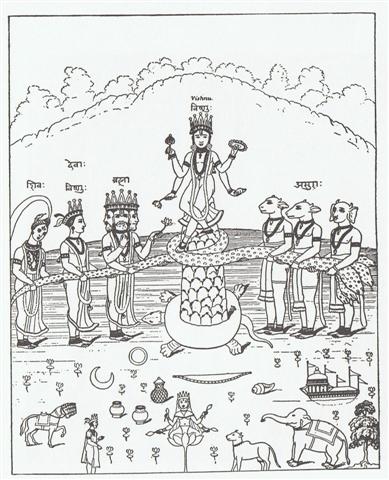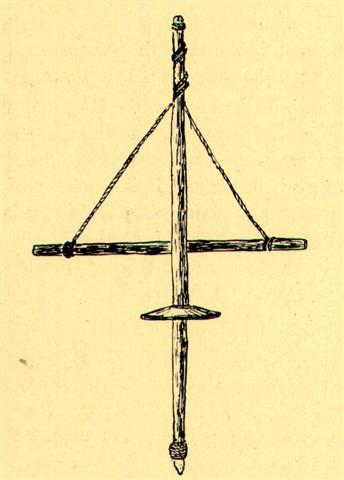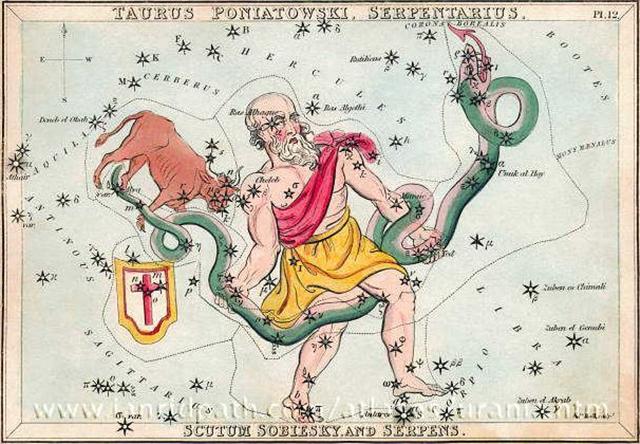My argumentation is leading up to a suggestion, viz. that the arrival in late November (cfr Ga7-12) of the Serpent (Sweet Water) Holder (Ophiuchus, the Tanist of Hercules, the dry Summer Giant) - wielding his spear of ash (as in ashes, ehu) - had to be 68 days after the star date *JULY 7 (cfr Ca13-16), when the terminal month of Jupiter had finished. 188 (*JULY 7) + 68 (precessional days) = 256 (September 13). The time of the Tanist was defined from the ancient positions of the stars, not from the current time of the Sun. ... Midsummer is the flowering season of the oak, which is the tree of endurance and triumph, and like the ash is said to 'court the lightning flash'. Its roots are believed to extend as deep underground as its branches rise in the air - Virgil mentions this - which makes it emblematic of a god whose law runs both in Heaven and in the Underworld ... The month, which takes its name from Juppiter the oak-god, begins on June 10th and ends of July 7th. Midway comes St. John's Day, June 24th, the day on which the oak-king was sacrificially burned alive. The Celtic year was divided into two halves with the second half beginning in July, apparently after a seven-day wake, or funeral feast, in the oak-king's honour ... 188 (*JULY 7) + 7 = 195 (*JULY 14), and the 2nd half of the year should therefore begin after *Ca14-3:
... 'Then', declared Odysseus, I thrust in that stake under the deep ashes, until it should grow hot, and I spake to my companions comfortable words, lest any should hang back from me in fear. But when that bar of olive wood was just about to catch fire in the flame, green though it was, and began to glow terribly, even then I came nigh, and drew it from the coals, and my fellows gathered about me, and some god breathed great courage into us. For their part they seized the bar of olive wood, that was sharpened at the point, and thrust it into his eye, while I from my place aloft turned it about, as when a man bores a ship's beam with a drill while his fellows below spin it with a strap, which they hold at either end, and the auger runs round continually ...
The key number 68 was equal to the number of right ascension days from 0h (March 21) at the time of rongorongo down to the ancient time when Aldebaran had risen together with the Sun at 0h:
At the time of Gregory XIII, 4 precessional days earlier than at the time of rongorongo, Ain would have risen with the Sun in °May 21 (141) = 64 days after MARCH 22 (81). At the time of Gregory the key number was 64, not 68. But Gregory had moved the date for spring equinox from the previous Julian day 84 (counted from the beginning of the year) to day 80. Therefore Aldebaran would at that time have risen with the Sun 4 days too late in his calendar (as measured from the equinox) compared to the ancient structure. Thus he had pushed the fixed stars ahead with 4 precessional days - apparently changing the real key number at his time from 64 to 68. However, at the time of rongorongo, 4 precessional days later, the 'crooked canoe' of the Pope could be straightened up with heliacal Aldebaran once again truly arriving at its proper place 68 days after 0h. Although after a further 71 years ahead into the future the Sun would move the equinox another precessional day earlier in the year, changing the key number to 69. ... They go inland at the land. The child nursed and tended grows up, is able to go and play. Each day he now goes off a bit further away, moving some distance away from the house, and then returns to their house. So it goes on and the child is fully grown and goes to play far away from the place where they live. He goes over to where some work is being done by a father and son. Likāvaka is the name of the father - a canoe-builder, while his son is Kiukava. Taetagaloa goes right over there and steps forward to the stern of the canoe saying - his words are these: 'The canoe is crooked.' (kalo ki ama). Instantly Likāvaka is enraged at the words of the child. Likāvaka says: 'Who the hell are you to come and tell me that the canoe is crooked?' Taetagaloa replies: 'Come and stand over here and see that the canoe is crooked.' Likāvaka goes over and stands right at the place Taetagaloa told him to at the stern of the canoe. Looking forward, Taetagaloa is right, the canoe is crooked. He slices through all the lashings of the canoe to straighten the timbers. He realigns the timbers. First he must again position the supports, then place the timbers correctly in them, but Kuikava the son of Likāvaka goes over and stands upon one support. His father Likāvaka rushes right over and strikes his son Kuikava with his adze. Thus Kuikava dies. Taetagaloa goes over at once and brings the son of Likāvaka, Kuikava, back to life. Then he again aligns the supports correctly and helps Likāvaka in building the canoe. Working working it is finished ... *JULY 7 (188) + 68 = 256 (= 16 * 16), i.e. *SEPTEMBER 13, was at the heliacal Sting (the Tail Fin) of the Scorpion (the Shark). The beginning of side a on the G tablet corresponded to the situation at the time of Gregory XIII, when spring equinox just had been relocated to Ain from its earlier position defined from heliacal Aldebaran. Therefore tamaiti in Ga7-11 had to be at glyph 180 - because the text was using the Gregorian calendar:
... If Jupiter corresponded to the eye - as the Chinese asserted - and if this eye was swallowed by Death-is-Near in day 357, then Jupiter ought to have been (re)born around day 357 - 398 (synodic cycle of Jupiter) = 365 + 357 - 398 = 324 (10 days after 314), i.e. in November 20, where indeed there is a tamaiti (little child) in the G text ...
The rain making type of glyph (haka-ua) is similar to the little child (tama-iti). This is no coincidence, because the season of fruits (offspring) was depending on the arrival of rain from the sky above (ragi). ... It was 4 August 1968, and it was the feast day of Saint Dominic, patron of Santo Domingo Pueblo, southwest of Santa Fe. At one end of the hot, dusty plaza, a Dominican priest watched nervously as several hundred dancers arranged in two long rows pounded the earth with their moccasined feet as a mighty, collective prayer for rain, accompanied by the powerful baritone singing of a chorus and the beat of drums. As my family and I viewed this, the largest and in some ways the most impressive Native American public ceremony, a tiny cloud over the Jémez Mountains to the northwest got larger and larger, eventually filling up the sky; at last the storm broke, and the sky was crisscrossed by lightning and the pueblo resounded with peals of rolling thunder ...
On side b of the G tablet the number of glyphs was designed to be 242, which gives us a hint of why the ure figure in Ga7-13 is holding a hatchmarked (dark) henua in front. The date in the Gregorian calendar was °November 18 = 242 days after 0h, i.e. 121 (= 11 * 11) days after °May 1 (121). There were 4 * 20 = 80 days (like the time from January 1 to 0h) with rain clouds containing drops like grapes (fruits) beyond midsummer:
Precession had made a crack in the hard shell of the year and it was placed at high summer. This crack was expanding with time, with one half of the year containing fresh air and a Sun who dried everything up, whereas the other half had a sky covered with rain clouds and with a fresh virgin earth below. ... 'The life-force of the earth is water. God moulded the earth with water. Blood too he made out of water. Even in a stone there is this force, for there is moisture in everything. But if Nummo is water, it also produces copper. When the sky is overcast, the sun's rays may be seen materializing on the misty horizon. These rays, excreted by the spirits, are of copper and are light. They are water too, because they uphold the earth's moisture as it rises. The Pair excrete light, because they are also light ... 'The sun's rays,' he went on, 'are fire and the Nummo's excrement. It is the rays which give the sun its strength. It is the Nummo who gives life to this star, for the sun is in some sort a star.' It was difficult to get him to explain what he meant by this obscure statement. The Nazarene made more than one fruitless effort to understand this part of the cosmogony; he could not discover any chink or crack through which to apprehend its meaning. He was moreover confronted with identifications which no European, that is, no average rational European, could admit. He felt himself humiliated, though not disagreeably so, at finding that his informant regarded fire and water as complementary, and not as opposites. The rays of light and heat draw the water up, and also cause it to descend again in the form of rain. That is all to the good. The movement created by this coming and going is a good thing. By means of the rays the Nummo draws out, and gives back the life-force. This movement indeed makes life. The old man realized that he was now at a critical point. If the Nazarene did not understand this business of coming and going, he would not understand anything else. He wanted to say that what made life was not so much force as the movement of forces. He reverted to the idea of a universal shuttle service. 'The rays drink up the little waters of the earth, the shallow pools, making them rise, and then descend again in rain.' Then, leaving aside the question of water, he summed up his argument: 'To draw up and then return what one had drawn - that is the life of the world.'
|
||||||||||||||||||||||||||||||||||||||||||||||||||||||||||||||||||||||||||||||||||||||||||||||||||||||||||||||||||||||||||||||||||||||||||||||||||||||||||||||||||||||||||||||||||||||||||||||||||||||||||||||||||||||||||||||||||||||||||||||||||||||||||||||||||||||||
































